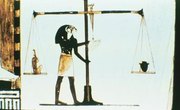Shakespeare's "The Merchant of Venice" explores the sin of greed through multiple plot lines, the best known of which is the lender Shylock demanding his pound of flesh when Bassanio cannot repay his debt. Another plot line involves the suitors vying for the hand of the rich and beautiful Portia. Before her father died, he set up a test involving three symbolic caskets to find out who would be the most worthy suitor.
Gold, Silver and Lead
In the test, suitors are presented with three caskets: one made of gold, one of silver and one of lead. If the suitor chooses the correct casket, he wins Portia's hand. The gold casket is a symbol of greed and of materialistic and shallow people who value surface over substance. Silver, while still precious, is not quite as luxurious as gold. The silver casket symbolizes a more cautious greed. These are the people who make compromises in trying to fulfill their dreams -- wanting to go for the gold but falling short. The lead casket ends up being the right choice. It is plain on the inside, but it holds an inner treasure. It represents Portia herself, who may one day grow old and plain, but who is beautiful and valuable on the inside. The inscription on the lead casket also says "Who chooses me must give and hazard all he hath," which is the same in marriage.
Related Articles
References
Writer Bio
Maria Magher has been working as a professional writer since 2001. She has worked as an ESL teacher, a freshman composition teacher and an education reporter, writing for regional newspapers and online publications. She has written about parenting for Pampers and other websites. She has a Master's degree in English and creative writing.











